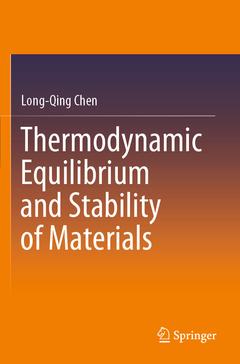Thermodynamic Equilibrium and Stability of Materials, 1st ed. 2022
Auteur : Chen Long-Qing

Uses straightforward language to explain the mathematical beauty of thermodynamics
Offers a step-by-step procedure for computing all thermodynamic properties
Highlights the two most important concepts: the fundamental equation of thermodynamics and chemical potential
Date de parution : 01-2023
Ouvrage de 455 p.
15.5x23.5 cm
Disponible chez l'éditeur (délai d'approvisionnement : 15 jours).
Prix indicatif 63,29 €
Ajouter au panierDate de parution : 12-2021
Ouvrage de 455 p.
15.5x23.5 cm
Thèmes de Thermodynamic Equilibrium and Stability of Materials :
Mots-clés :
Thermodynamics textbook; Chemical Potential; Fundamental Equation of Thermodynamics; Internal Energy; Enthalpy; Entropy; Free Energy; Thermodynamics of Materials; Phase Equilibria; Chemical Reactions; Reaction Equilibria; Electrochemistry; Energy Conversion; Maxwell Relations; Property Relations; Thermodynamic Properties; Laws of Thermodymamics



